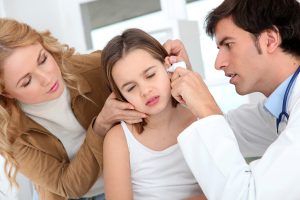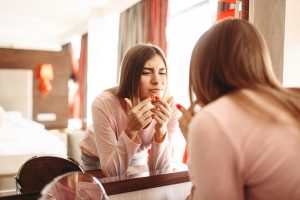Bumps, sores, and blisters are all common symptoms of STDs. Chlamydia is one STD that commonly causes bumps.
Chlamydia bumps can occur in both men and women and are often mistaken for other skin conditions, such as ingrown hairs, genital warts, or herpes, which is why it’s essential to get tested if you suspect you may have an STD.
In the meantime, here is everything you should know about these frustrating little bumps.
What Are Chlamydia Bumps?
Chlamydia bumps are small, raised bumps that can appear around the genitals, anus, or throat. They are often red, yellow-white, or skin-colored and may be followed by other symptoms such as itching, burning, and pain.
These bumps are caused by the bacteria chlamydia trachomatis, which is spread through sexual contact with an infected person.
Chlamydia infections are widespread, especially among young adults. Chlamydia is the most commonly reported STD in the United States.
Although these bumps are not usually painful, they can be very itchy and uncomfortable.
If not treated, chlamydia can lead to severe health conditions such as infertility, ectopic pregnancy, and pelvic inflammatory disease.
If you see chlamydia bumps on your body, you must immediately see your doctor or another healthcare provider. They will be able to prescribe antibiotics to fight the infection.
It’s also essential to inform any recent sexual partners so they can get tested and subsequently treated, if necessary.
Does Chlamydia Cause Bumps on Skin?
Various things, including infection, inflammation, or allergic reactions, can cause bumps on the skin. In some cases, bumps may indicate a more serious underlying condition.
If you have bumps on your skin accompanied by other symptoms, you must see a doctor to rule out any potential problems.
If you suspect that you may have an STD and you see bumps on your skin, getting tested as soon as possible is vital. This ensures you do not have a more serious sexually transmitted disease like HIV.
Getting tested as early as possible will also ensure you can begin treatment immediately, if necessary.
Are Bumps on the Tongue a Sign of Oral Chlamydia?
Bumps on the tongue indicate many conditions, ranging from allergies to infection. Oral chlamydia is one potential cause of bumps on the tongue, although this is relatively rare.
Other symptoms of oral chlamydia include white spots on the throat or tonsils, sore throat, and difficulty swallowing. Unfortunately, many people are unaware that they have oral chlamydia, as the symptoms are often mild and can go unnoticed.
The best way to prevent catching oral chlamydia is to practice safe sex. This means using condoms or other barrier methods during sexual intercourse.
It is also essential to restrict the number of sexual partners you have. If you are sexually active and under age 25, you should get tested for chlamydia and other STIs regularly.
If you have a history of STIs, you may have a higher risk of contracting oral chlamydia. In this case, you must discuss ways to reduce risk with your doctor.
There is no vaccine for chlamydia, so it is vital to take steps to prevent infection.
Chlamydia Bumps on Tongue
Chlamydia is a bacteria that can cause infection in any body part, including the mouth and, in this case, the tongue. Although chlamydial bumps on the tongue are not common, they can occur, and you can get them through oral sex.
It’s also hard to tell what these bumps are in pictures because they can look like many other things, such as oral thrush, tonsillitis, or even just an infection in the throat.
To get a better idea of your bumps, you can search online through the Chlamydia – CDC Fact Sheet (Detailed) website and get more information about other symptoms you may have that can help identify the issue. In addition, it will provide additional information, such as a chlamydia overview, symptoms, treatment, and more.
Chlamydial Bumps on Inner Thigh
The inner thighs are a regular place for rashes and other skin problems. In addition, this area is warm and moist, which makes it a perfect environment for bacteria to thrive.
It’s also prone to friction and exposure to irritants like soap which can irritate the skin and lead to rashes.
There are a few sexually transmitted infections (STIs) that can cause bumps on the inner thighs, such as genital herpes, secondary syphilis, herpes simplex virus, and chlamydia.
There are several home remedies and preventive measures that can help reduce your risk of developing bumps on your inner thighs, such as:
- Wearing loose-fitting clothing, avoiding tight-fitting jeans or pants
- Keeping the area clean and dry
- Avoid sharing towels, clothing, or other personal items with someone who has been infected
- Applying a cool compress to the area to soothe any irritation
- Using a doctor-prescribed topical cream or ointment to help relieve itching
Chlamydial Bumps on Penis
Bumps on or around the genitals or rectum are usually caused by pubic lice (crabs). Chlamydia, however, can also cause these bumps.
Like most STDs, chlamydia is passed through sexual contact and can infect the penis, vagina, cervix, anus, urethra, and eye.
In men, chlamydia often causes no symptoms, but it can lead to inflammation of the testicles and pain when urinating.
Although rare, if left untreated, chlamydia can result in a painful condition of the testicles that can cause infertility in men.
Chlamydial Bumps on Shaft
Sexually transmitted infections are a huge problem in the United States and globally.
A chlamydia diagnosed male with herpes can present with bumps on the shaft or scrotum. These bumps are usually painless but can be itchy.
Diagnosing bumps on the shaft can be tricky because they can be confused with other STDs or STIs.
To determine if the bumps are indeed chlamydia, your doctor will ask the following questions:
- When did you first notice the bumps?
- Do the bumps itch or hurt?
- Are the bumps filled with pus?
- Have you had unprotected sex in the past three months?
- Have you been diagnosed with chlamydia before?
Your doctor will also conduct a physical examination, and your doctor may take a swab from the bumps to test for the presence of chlamydia.
Chlamydial Bumps on Vagina
Bumps in the vagina can be caused by bacterial vaginosis, yeast infection, syphilis, chancroid, and HPV.
STDs like Lymphogranuloma venereum (LGV) and chlamydia can also cause bumps.
That’s why it’s essential to get tested if you notice any.
These problems, especially for pregnant women, can cause significant health issues like severe inflammatory disease and infertility.
To avoid these bumps, you should:
- Maintain proper hygiene by taking frequent showers
- Use condoms during sex
- Shave properly
- Avoid tight clothing
- Change out of wet clothes
- Do not use irritating feminine products
If you notice any bumps on your vagina, you must get tested and see a healthcare professional as soon as possible for proper diagnosis and treatment.
Chlamydial Bumps on Lips
Chlamydia is passed through sexual contact, including vaginal, anal, and oral sex. You can get chlamydia by contacting the infected bodily fluids of someone who has it, and oral chlamydia is no different.
Oral chlamydia can potentially cause bumps on the lips, a severe STD that can cause long-term health complications.
With that said, you can prevent developing chlamydial bumps on your lips by:
- Practicing safer sex
- Using dental dams or condoms every time you have oral, vaginal, or anal sex
- Limiting your number of sexual partners
- Getting tested regularly for STDs
Early detection of chlamydia is key to preventing severe sexual health complications.
When To See a Doctor
It’s always best to err on caution regarding your health. It is always the best option to consult with a medical specialist if you are experiencing any symptoms, no matter how mild.
Symptoms of chlamydia often go away within a few weeks without treatment, but the infection stays in your body. Untreated chlamydia can cause severe health problems.
You should see a healthcare specialist immediately if you experience any of the following symptoms:
- A burning sensation when urinating
- An unusual discharge from the penis
- Pain and swelling in the testicles
- A burning sensation when urinating
- An unusual discharge from the vagina
- Pain during sex
- Bleeding between periods
- Lower abdominal pain
You can treat chlamydia by taking antibiotics which a doctor can only prescribe. Your doctor will also prescribe treatments for chlamydia bumps that can help to reduce swelling and irritation.
Remember that with proper knowledge and treatment, you can help stop the chlamydia spread to others.
Frequently Asked Questions (FAQs)
The most common symptoms in men are pain or burning with urination and discharge from the penis. These symptoms can be mild or severe. Sometimes men with chlamydia have no symptoms at all.
Chlamydia is treated with antibiotics. The most common antibiotics for chlamydia are azithromycin (Zithromax) and doxycycline. These antibiotics are taken orally with the proper dosage prescribed by a doctor.
It is not uncommon to still feel symptoms a day or two after starting treatment. In some cases, symptoms may persist for more than a week. However, if you experience symptoms beyond that, please consult your doctor.
The treatment for chlamydia is very effective, but the result varies from person to person. In general, chlamydia goes away within two weeks.
However, some people may take months or even years for the infection to clear up completely.
Your doctor can detect chlamydia through a urine test or a swab of the infected area. It usually takes about 1-2 weeks for chlamydia to show up on a test.
It is possible to get chlamydia from kissing, but it is not a very common way to contract the infection.
Although kissing can spread other diseases, such as cold sores, chlamydia is most commonly spread through sexual contact.
It is possible to develop sores with chlamydia, but they are usually not painful.
These sores can appear around the genitals or rectum and are typically small and barely noticeable, or they may be large and painful.
Sores can also appear on the lips, mouth, or throat. It is vital to note that not everyone who has chlamydia will develop sores.





